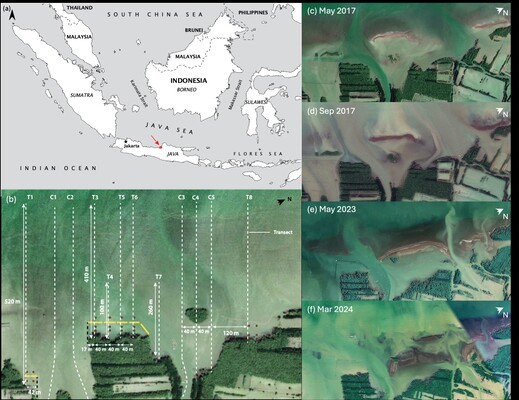S.A.J. Tas1*, A. Gijón Mancheño2 , A.J.H.M. Reniers2
1 Wageningen University and Research, the Netherlands; 2 Delft University of Technology, the Netherlands
* Corresponding author: silke.tas@wur.nl
Introduction
Cheniers are ridges or bars composed of wave-reworked coarse-grained sediments, resting on and surrounded by muddy sediment (Otvos and Price, 1979; Augustinus 1989). Although cheniers require a specific balance between sediment availability and wave action, they occur in diverse locations worldwide ranging from micro- to macrotidal environments across all latitudes. Chenier coastlines, characterized by fine sediments with a minor fraction of coarse particles, exhibit mildly sloping foreshores and low to moderate wave energy. These coastlines are particularly vulnerable to coastal erosion, and cheniers often form through the reworking of eroded sediments by waves. In turn, cheniers can act as natural buffers against wave attack, stabilizing eroding coastlines (Anthony et al., 2019; Tas et al., 2022a).
Objective and Methods
Unlike bars and beach ridges on sandy shores, which consist of material similar to the adjacent beach and shoreface, the volume of a chenier is limited by the availability of coarser particles in the otherwise muddy shoreface. Consequently, when subject to wave action, cheniers typically migrate (in cross-shore and/or longshore directions) rather than building out, due to the lack of additional coarse sediment. Understanding these chenier dynamics is crucial for improving predictions of vulnerable muddy coastline evolution.
This study aims to enhance our understanding of 2D chenier dynamics (cross-shore and longshore) under daily wave and tidal influences to evaluate their impact on shoreline evolution over decadal timescales. As a first step, a process-based numerical model (Delft3D) is developed to simulate 2D chenier dynamics, expanding upon the 1D model setup by Tas et al. (2022b). This model is calibrated using measured bathymetric transects.
Results
A morphodynamic monitoring campaign conducted between August 2021 and September 2022 in Demak, Indonesia (Fig. 1a), observed a chenier migrating diagonally across shore-normal transects (Fig. 1b) (Gijón Mancheño et al., under review). A bathymetry representative of August 2021 is approximated based on older bathymetry, monitored transects and Google Earth satellite images, and used as the initial condition for the Delft3D model. The 2D chenier dynamics are then simulated over the course of the year. However, process-based models are computationally expensive for long-term predictions (beyond seasonal timescales). Therefore, a reduced-complexity approach, building upon the idealized chenier model of Tas et al. (2022a) is explored to simulate 2D chenier dynamics on decadal timescales.
Acknowledgements
The data used in this study was collected as part of a project funded by NWO, under project number 18473.

Figure 1. (a) Location of Demak, Indonesia. (b) Location of the morphodynamic monitoring transects. (c-f) 2D chenier evolution between May 2017 and March 2024 (Google Earth)
References
Anthony, E. J., Brunier, G., Gardel, A., & Hiwat, M. (2019). Chenier Morphodynamics on the Amazon-Influenced Coast of Suriname, South America: Implications for Beach Ecosystem Services. Frontiers in Earth Science, 7, 35. https://doi.org/10.3389/feart.2019.00035
Augustinus, P. G. E. F. (1989). Cheniers and chenier plains: A general introduction. Marine Geology, 90(4), 219–229. https://doi.org/10.1016/0025-3227(89)90126-6
Otvos, E. G., & Price, W. A. (1979). Problems of chenier genesis and terminology—An overview. Marine Geology, 31(3–4), 251–263. https://doi.org/10.1016/0025-3227(79)90036-7
Tas, S. A. J., van Maren, D. S., Helmi, M., & Reniers, A. J. H. M. (2022a). Drivers of cross-shore chenier dynamics off a drowning coastal plain. Marine Geology, 445, 106753. https://doi.org/10.1016/j.margeo.2022.106753
Tas, S. A. J., van Maren, D. S., & Reniers, A. J. H. M. (2022b). Chenier Formation Through Wave Winnowing and Tides. Journal of Geophysical Research: Earth Surface, 127(10). https://doi.org/10.1029/2022JF006792










